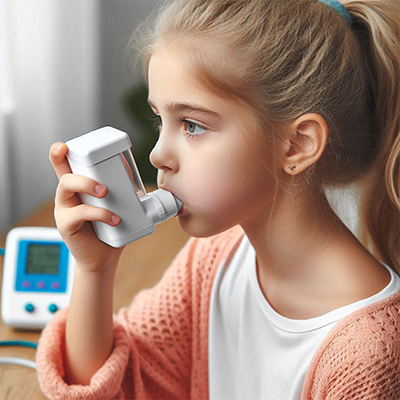Exhaled Nitric Oxide (FeNO) Testing
FeNO (fractional exhaled nitric oxide) testing is a simple, non-invasive breathing test that measures the amount of nitric oxide in your child’s breath. This gas is naturally produced in the lungs but can be elevated when the airways are inflamed, especially in conditions such as asthma or allergic airway disease.
FeNO testing is suitable for most children over 3 years of age and is used both to help diagnose asthma and guide treatment.
What Is a FeNO Test?

The test measures how much nitric oxide is exhaled during a slow, steady breath. A higher level suggests inflammation in the airways, commonly found in asthma. It helps doctors by:
- Supporting asthma diagnosis (alongside clinical history and other tests like spirometry)
- Monitoring airway inflammation
- Guiding medication decisions and dose adjustments
- Distinguishing asthma from other breathing disorders
Why Is FeNO Elevated in Asthma?
Asthma causes inflammation in the lining of the airways. This “quiet” inflammation may not cause immediate symptoms but increases nitric oxide levels. FeNO helps detect inflammation early and track how well treatment is working. Persistent high levels can indicate a higher risk of asthma attacks and worsening symptoms.
Why Is FeNO Testing Important?
FeNO testing is especially useful to:
- Detect eosinophilic (allergic) airway inflammation
- Identify children who are likely to benefit from inhaled corticosteroids
- Assess whether current asthma treatment is working
- Reduce the need for invasive tests like bloods or sputum samples
How Is the Test Done?
The test is quick and painless:
- Your child sits upright and is guided through the process
- They take a deep breath in
- They breathe out slowly and steadily into a handheld device
- A visual display may help them keep a steady flow
- The result (in parts per billion, or ppb) appears on the screen
Sometimes the test is repeated to ensure accuracy. The whole process takes around 5–15 minutes.
Understanding the Results
Children (5–16 years):
- 35 ppb – High: suggests allergic asthma
- 20–35 ppb – Intermediate: result considered with symptoms
- <20 ppb – Low: allergic asthma unlikely
Ages 16 and above:
- 50 ppb – High
- 25–50 ppb – Intermediate
- <25 ppb – Low
Your doctor will explain the result and how it fits with your child’s symptoms and history.
Preparing for the Test
To ensure the most accurate results:
- Avoid food and drink for 1 hour before
- No strenuous activity for 1 hour before
- No caffeine or fizzy drinks for 2 hours before
- Avoid reliever inhalers (e.g. salbutamol) for 6 hours unless advised otherwise
Sometimes the test is repeated to ensure accuracy. The whole process takes around 5–15 minutes.
Is FeNO Testing Safe?
Yes. The test is completely safe, non-invasive, and needle-free. Some children may feel slightly lightheaded from blowing too forcefully, but this is very rare and temporary.
Frequently Asked Questions (FAQs)
How long does the test take?
About 5–15 minutes, including instructions.
Can my child eat or drink beforehand?
No. Please avoid food or drink for 1 hour before the test.
Will the test need to be repeated?
Possibly, especially if symptoms change or don’t improve.
What if my child is nervous?
Our team is experienced in working with children and will make sure your child feels safe and supported throughout the process.
Further Information
You can read more about FeNO testing in this NHS leaflet:
NHS FeNO Testing Information Leaflet (PDF)
Located in London | Infants to young adults seen
Request a referral or book an appointment with Professor Gupta today.
